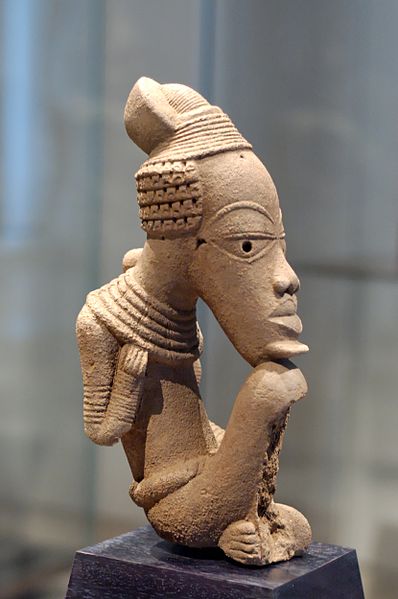|
|
Post by zarahan on Mar 27, 2014 11:29:01 GMT -5
Some threads have a lot of interesting info bearing on the question: This one aims to examine the topic in its own right. Some questions to consider:  What is a definition of West Africa? Can the customary "Neolithic" model be grafted wholesale on to Africa? How was West Africa shaped by climate and environment? Are West African populations a mostly in-situ development until very recently? Did they come from the East? If so when and who? Did they come from some other direction? If so when and who? What is the genetic history and pathways into the region? What is the current genetic makeup of West Africa? What were the first significant cultures? How did more elaborate cultures grow from the early localized ones? What was the influence of population migrations from the Sahara? say before 600AD? What was the influence of population migrations from the East? say before 600AD? What was the influence of population migrations from elsewhere? say before 600AD? What was the impact of pastoralism? What the impact of technologies developed elsewhere in Africa- iron-working for example? What are the "Pan-African" links of West Africa before the Arab and European interludes? --Please no off-topic stuff like Dravidians, albinos, Olmecs etc. Timeline is before European colonization period -------------- Post abstracts, articles, theories. models etc with direct relevance --------- Thanks -------------------------------------------------  OTHER ANGLES- adapted from UCLA History course outline- History 176A - OTHER ANGLES- adapted from UCLA History course outline- History 176A -
info on anything below also welcome.. Geographical diversity of West Africa - The environment and the peoples. Languages. The role of climate, disease and geographical resources on African history. Wet and dry Saharas - the climatic factor in West African history Creative origins - the aesthetic and economic heritage of the Late Stone Age. The rock art of the Sahara - interpretations and implications The origins of the agricultural way of life - hunters and gatherers, pastoralists, and villagers questions of diffusion versus independent development Chariots and crucibles - copper and iron - early metallurgists in Niger (Agadez), Mauretania and Nigeria. Technologies for development, iron and the taming of the forest and the expansion of African agriculture Early complex societies in west Africa- the importance of natural resources. Senegambian megaliths and tumuli and possible clues to the rise of Ancient Ghana. Before Mali, the Inland Niger Delta and the earliest sub-Saharan town, Jenne-Jeno. Nigeria in the first millennium AD - Nok and Igbo Ukwu The Islamic factor in west African history. Literacy and culture, trade and religion. The pilgrimage and links to the wider world. Ancient Ghana - evidence and speculation. Oral history, remote Arab reporting, no eyewitness accounts and uncertain archaeology. The Sahara and Saharan trade - barrier or connection ? Mali in its prime - Sundiata founding, Mansa Musa visiting, Ibn Battuta reporting Songhai - the nature and decline of the Sudanic States. |
|
|
|
Post by zarahan on Mar 27, 2014 11:30:20 GMT -5
www.ounjougou.org/sec_arc/arc_main.php?lang=en&sec=arc&sous_sec=neo&art=neo&art_titre=conceptTHE NEOLITHIC IN AFRICAArcheology, Late Stone Age/Neolithic Arguments for an Early Neolithic in Sub-Saharan Africa Fulani herd in the Inland Niger Delta. Photo E. Huysecom. Introduction Recent discoveries at Ounjougou reveal that Africa has experienced one of the most ancient ceramics in the world, at the beginning of the 10th millennium BC, while recent research in context Sahara and the Nile Valley demonstrate the practice of domestication of bovines in the course of the 9th millennium BC, more than 1000 years before Greece and the Middle East. Bozo fishing camp in the Inland Niger Delta. Photo E. Huysecom. Use of the term "Neolithic" in Africa: two schools of thought For Europe and the Near East, the term "Neolithic" designates sedentary societies whose economy is based on a system of production of food-producing goods. Apart from a few rare exceptions, the Neolithic is characterized here by the adoption, in varying order, of animal domestication, agriculture, ceramic production and sedentation. At some point later on, this process ended, for cereal-growing societies, with urbanization. In Africa, by contrast, the process of "Neolithization" is unclear. Its acceptance by researchers varies according to region or even human groups, and the uneven quality of research does not aid in understanding. So, we observe that the same site may be considered, depending on the author, to be Neolithic, Proto-Neolithic, Meso-Neolithic, Epipaleolithic or Final Paleolithic! This lack of terminological coherence makes overall understanding of the processes difficult. Considering all the data, two opposing currents of thought exist: one gives priority to the material culture, the other to a range of economic activities. In the first view, material assemblages prior to the advent of metallurgy are determined to be Neolithic or not on the basis of the presence of absence of pottery. This approach has the merit of being practical, but in its brutal simplicity, does not take into account the economic distinctiveness of diverse societies. In the second view, the term Neolithic is employed only to designate cultures prior to the age of metals for which archaeologists can demonstrate the existence of a true production economy. This approach thus concurs with the model for the Near East and Europe, which, in comparison with the approach based on the presence of pottery, is more satisfying since the economic characteristics of the societies are taken into account. However, this approach most often excludes the Neolithic from Africa, because in practice, the organic remains of the different production systems are so poorly preserved in the Sub-Saharan tropical acidic iron-rich soils that it is impossible to find evidence for the practice of animal husbandry or agriculture. We can, certainly, return to other evidence, such as rock art to identify animal husbandry, or low stone walls to infer the use of farming perimeters, but their dating is often difficult and their interpretation ambiguous. The presence of silos and grinding materials could as easily be associated with the management of wild grains as with domesticated cereals. Apart from these difficulties, we think – mainly because it is still in part the case today – that Africa developed societies with very different economies, for which the mechanisms cannot be compared to those – European or Near Eastern – used as references. It is rare to find, before the Iron Age, African societies that warrant the qualification "Neolithic" in its European sense, that is to say, sedentary populations jointly including animal husbandry, agriculture and pottery. Wart hog meat smoking in the Baoulé. Photo E. Huysecom. The "African Neolithic": considerations and proposal For all that, to refuse Neolithization to Sub-Saharan societies is Eurocentric and dangerous. Once simplified and removed from its context, this idea opens the way to political appropriation and a frequently disparaging direction characterized by remarks about Africa of the style: the "continent that discovered neither the wheel, nor writing nor the Neolithic", etc. This is not only detestable, but we have seen, very much false. So how to approach Neolithization in Africa? Without raising controvery or losing ourselves in a debate that has dragged on for decades, we defend three ideas, in our view essential to characterize the African Neolithic by what it is proper to it. The first is that pottery-making societies that appeared in Africa from the beginning of the Holocene can be considered Neolithic, or at least proto-Neolithic, even if the sedentary way of life or the domestication of plants and animals were not concurrently practiced. We emphasize that the creative shaping of clay and its firing evidence a type of influence of humans on the environment entirely different from hunter-gatherer societies. A similar invention could only have repercussions on the social division of labor and knowledge, with respect to the technical information needed to recognize the quality of clays and tempers, firing parameters and shaping techniques. Such a practice is also incompatible with the high degree of mobility of hunter-gatherers, given that clay sources are stationary and that the pottery made is fragile and heavy! So, the first cultures with pottery were societies in which to produce, one domesticated natural elements, whether these are clay, plants or animals… The transformation or domestication of natural elements in order to produce, is this not the essence of Neolithization? Bush honey harvesting in the Baoulé. Photo E. Huysecom. Second idea: the attributes of the African Neolithic system are the same as those in Europe – agriculture, animal husbandry, pottery, sedentation -, but, instead of being necessarily present simultaneously within a single population, could exist at the same time in several contemporaneous groups. Without this flexibility in the application of the traditional definition of the Neolithic, we risk concluding that no African society at the beginning of the Holocene could have been Neolithic. In fact, a number of rural African populations today have mobile phones and televisions, but do not practice agriculture and are not completely sedentary either. Moreover, many African peoples, instead of the global adoption of the "Neolithic kit" (herding-sedentation-agriculture-pottery), chose the path of the complementary of modes of subsistence, specializing in one or another of the domains of food production, and counted on their neighbors for complementary goods. From this a complex situation of interdependent relationships between different populations with varied activities was created, but which, altogether, exhibited all of the facets of a society considered Neolithic! Third idea: intensive selective foraging, that we define here as the systematic, rational and targeted collecting of certain edible wild plants, considered by its importance as a real procurement strategy for food staples, may have represented a significant, even sufficient, dietary source during the African Neolithic; yet their preparation assumes the use of the same cooking recipients and utensils as that for agricultural products. In a developmental historical process, we can consider such intensive selective foraging as characterizing an intermediary stage between hunter-gatherers and sedentary farmers. This form of "proto-farming" may have led to not only territorial organization including more or less important and regular land clearing, generally by burning that also favored the multiplication of grasses, but also to a certain degree of semi-sedentarity since seasonal halts in certain places propitious for foraging was imposed. This analysis is corroborated by ethnographic observations: in modern Mali, plants or wild grasses collected in the natural environment are still the focus of much commerce in the markets and are prepared with the same equipment and in the same way as agricultural products. Wild plants harvesting in Dogon Country. Photo C. Selleger. We see then that, very early, societies with a Neolithic way of life, but based on wild grains, appeared in Africa. These societies mastered pottery and probably other Neolithic techniques. They can be considered as Neolithic, provided that we accept the application of a less traditional explanation for Neolithization. Within this definition better suited to Africa, the same key elements as in the traditional definition are present – pottery, animal husbandry, agriculture, sedentation -, but within a group of interacting contemporaneous societies rather than within a single society. If we accept such flexibility and take into consideration the nearly systematic disappearance of organic remains in African sediments, it becomes clear than the societies at the beginning of the Holocene that were based on intensive selective gathering prepared and launched the early advent of a true African Neolithic system. Eric Huysecom
|
|
|
|
Post by zarahan on Mar 27, 2014 11:31:40 GMT -5
--------------------------------------------------------------------------------- FROM ES:
Dhar Tichitt
Abstract The sandstone escarpment of the Dhar Tichitt in South-Central Mauritania was inhabited by Neolithic agropastoral communities for approximately one and half millennium during the Late Holocene, from ca. 4000 to 2300 BP. The absence of prior evidence of human settlement points to the influx of mobile herders moving away from the “drying” Sahara towards more humid lower latitudes. These herders took advantage of the peculiarities of the local geology and environment and succeeded in domesticating bulrush millet – Pennisetum sp. The emerging agropastoral subsistence complex had conflicting and/or complementary requirements depending on circumstances. In the long run, the social adjustment to the new subsistence complex, shifting site location strategies, nested settlement patterns and the rise of more encompassing polities appear to have been used to cope with climatic hazards in this relatively circumscribed area. An intense arid spell in the middle of the first millennium BC triggered the collapse of the whole Neolithic agropastoral system and the abandonment of the areas. These regions, resettled by sparse oasis-dwellers populations and iron-using communities startwww.sciencedirect.com/science?_ob=ArticleURL&_udi=B6X1D-4WM051X-1&_user=10&_coverDate=09%2F30%2F2009&_rdoc=1&_fmt=high&_orig=search&_origin=search&_sort=d&_docanchor=&view=c &_searchStrId=1500770270&_rerunOrigin=scholar.google&_acct=C000050221&_version=1&_urlVersion=0&_userid=10&md5=668d034f4a90727b437b380654fa700c&searchtype=a [/QB][/QUOTE] 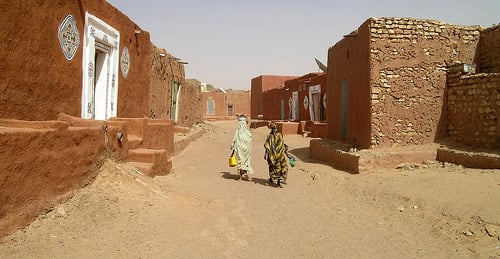 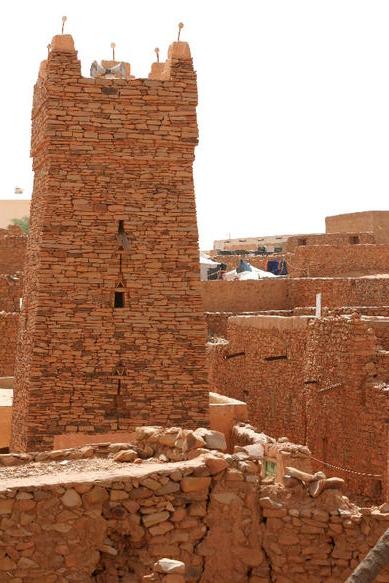 major trade route connected Ouadane with Oualata (Arabic: ولاته) (sometimes "Walata"), a ksar in the southeast part of the country. Oualata is believed to have been first settled by an agro-pastoral people akin to the Mandé Soninke who lived along the rocky promontories of the Tichitt-Oualata and Tagant cliffs of Mauritania. There, they built what are among the oldest stone settlements on the African continent. The modern city was founded in the eleventh century, when it was part of the Ghana Empire. It was destroyed in 1076 but re-founded in 1224, and again became a major trading post for trans-Saharan trade and an important center of Islamic scholarship. Oualata was a prosperous settlement, especially between the 14th and 18th centuries, such that it appeared on European maps. Trade was not its sole source of wealth; it had become a renowned intellectual center that attracted foreign students. A century ago, this oasis was farmland that produced enough food to feed a population of several thousand inhabitants. Today, the few wind-battered palm trees are dying, half-buried in sand.[2] Today, Oualata is home to a prized manuscript museum. Its buildings are trimmed with white drawings against a reddish-brown undercoat, making the city known for its highly decorative vernacular architecture. The designs on Oualata’s walls are the same as those still drawn on the hands and feet of Mauritanian women. Tichit Tichit (Arabic: تيشيت) sits at the foot of the Tagant plateau in south-central Mauritania on the route between Oualata and Ouadane. It was founded c. 1150 and grew into a magnificent city, and was a major trading center for salt. Its multi-storied structures–with blind walls on the ground floor, a door for only opening to the outside and facades built of colored stones–are fragile remnants of typical Mauritanian architecture. Its layout tells the history of the village. The northern section is the Shurfa quarter. This section was constructed in greenish stone, understood to be an expression of the tribe of the Shurfa's claim of decendancy to the Prophet Muhammad. The Masana tribe lived in the southern quarter, where red stone was used. This tribe was the largest in the settlement and known as good merchants. White stones were used for the larger buildings in this quarter.[3] While a variety of colored stones were used, each village section exists in polychrome. Legend has it that seven towns have been superimposed on this site, and the one that has come down to us today is irretrievably sinking beneath the dunes. Many of the houses have been swallowed by sand, only the upper stories of tall structures are visible. In 1999, torrential rains destroyed 80 percent of the town. The mosque and its square minaret survived.[4] Twenty to thirty houses remain in good condition, and are highly ornamented for the region. A few families reside in Tichit, where the main industry in Tichit is date farming. Traces of Tichit's glorious past remain in its vernacular architecture, which is its main attraction. The town is also home to a small museum. [/QB][/QUOTE] So now we have evidence of the origin of the Ghana Empire and proof of the Claims of Al-Bakri on the sophitication of Ghana.. Archaeological investigations in southern Mauretania have revealed a wealth of rather spectacular stone masonry villages which were occupied by prehistoric cultivators as early as 1000 B.C. It is argued that the inhabitants of these villages were Negro and very probably Soninke, and that the basic elements of their culture had developed without major influences from outside the area. The apparent sophistication and complexity of this cultural manifestation, combined with the close fit of developments in this area with Carneiro's theory of state formation, suggests that this prehistoric complex represented at least a powerful chiefdom which embodied many of the characteristics of subsequent West African states. The first demonstrable outside influences in the area began about 600 B.C. with the arrival of Libyco-Berbers from North Africa. Rather than causing still further cultural advances, the initial effect of this contact was the collapse of this sociopolitical organization. But with subsequent adjustment, plus the potential from trans-Saharan trade carried out by the North Africans, the basic, pre-existing pattern re-emerged, resulting eventually in a second and much more powerful African political organization in this area – the Ghana Empire.The town inhabited by the king is six miles from the Muslim one and is called Al Ghana. The area between the two towns is covered with houses made of stone and wood. The king has a palace and conical huts, surrounded by a wall-like enclosure. In the king’s town, not far from the royal court of justice, is a mosque. The Muslims who come on missions to the king pray there. There is one great avenue, which crosses the town from east to west. [/QB][/QUOTE] |
|
|
|
Post by zarahan on Mar 27, 2014 11:32:01 GMT -5
COPIED HERE: It's been my opinion that West Africa had long been inhabited before this time. Archeology seems to back this up. Yes, but not too many seem to want to add context explaining who these Africans were. This is the situation that we currently have to work with in regards to this ancient African archaeology. The settlements below seen in West Africa (Ghana-Mali/Burkina Faso) are the descendants of the Mande (Niger-Congo speakers) people (along that same Afro-Asiatic migration which ended around Northern West Africa) who settled Dhar Tichitt in Mauritania. These people migrated further south creating ancient Ghana (Mali/Burkina Fasco) which many say is a lot older than tradition sources detail. The Kintampo rock shelter found in the modern country of Ghana was likely a small group of wanderers who broke off from the ancient Ghana empire, and reason why I (on top of it being the leading theory as shown in the link) infer that they were from that ancient civilization is because cattle domestication was evident in that site. 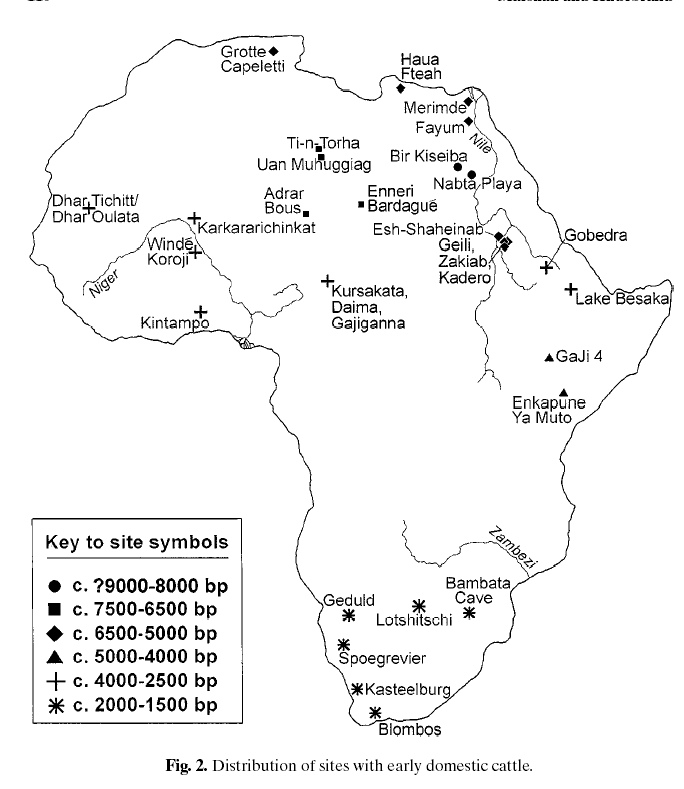 This migration explains how those early groups of Niger-Congo speakers ( Mande) migrated to that area of West Africa from their original East African (Sudan) homeland. The so-called "Afro-Asiatic" migration (note Dar Tichitt in Mauritania/The far West):  But when this migration is put into proper context ( African) The reference to "Bantu" can and has been applied to the broader Niger-Congo languages. As far the Nilotic Nilo-Saharan situation observe the maps below   Nilotic-Nilo-Saharan Nilotic-Nilo-Saharan migration into Lake Chad and eventually the ancient Sahara.: 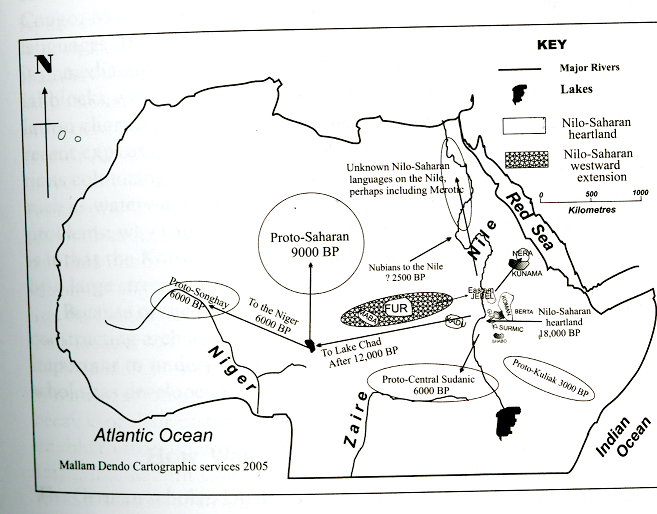 You wish to believe that somewhere in this mix of the archaeological sites in West Africa above is the evidence for the East to West migration of M2 lineage carrying, Niger Congo speakers into tropical West Africa that Western scholars like Christopher Ehret have been putting out: Do you see any evidence of an East to West migration of Niger-Congo speakers around 12,000 years ago indicated anywhere on that map? Now after reviewing all of those maps and reading what Christopher Ehret said is it not clear that his version of events is not substantiated with the evidence?  The Bantu migration above is in accordance with Western scholarship. This migration as you can see is NOT supported by the archaeological (or any evidence really) evidence shown above. It makes no sense when you really analyze it, hence this is an indoctrinated lie (notice this map is obviously from a school book). |
|
|
|
Post by zarahan on Mar 27, 2014 11:33:01 GMT -5
COPIED HERE: You your self posted this pic of a broad featured Nilo Saharan compare her with the aquiline features of the Bantu lady above,thus making my point you can't go around claiming that anyone feature is unique to any group of Africans.Man...so basically you just really will not accept the biological fact that Nilotic Africans do in fact have their own distinctive phenetic traits (and genetic), which has been validated in anthropological analysis? You are really having a difficult time when I say that I can easily distinguish a Dinka or Nuer from a Yoruba or Ibo individual (save the picture spam).. Ok cool whatever.... So not only will you not accept that Nilotes have a distinctive phenotype, but you also claim that you (an African American presumably) don't descend from the groups shown in the lime green below but rather the Nilotic Africans shown in the Orange: 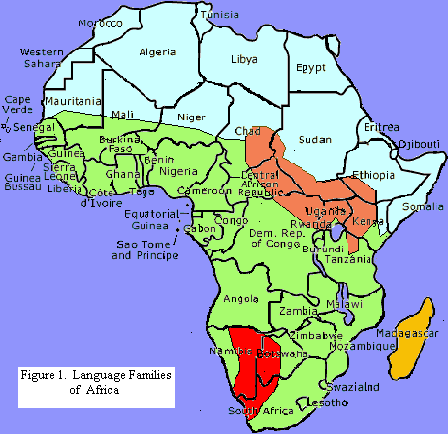 Transatlantic slave trade: Transatlantic slave trade:
 ... Ok ( Phew). |
|
|
|
Post by zarahan on Mar 27, 2014 11:33:47 GMT -5
COPIED HERE:
anansi
Mar 22, 2014 anansi said:
Asante
Yes I really will not accept the above because it is bunk!
The picture spam you bought up and it hurts your case whenever I respond to them don't deal with it fine by me.. do the head in the sand thingy.
Red herring tactic I said no such thing,the orange and other areas of your map did include captives bound for the Americas including the yellow,as a ship load of them landed in Jamaica which they escaped en-mass to the mountains shortly after their landing to form their own Maroon community, later to be absorbed by the mainly Akan group,also your map did not tell you that Mai Idris Alooma of Kanem-Bornu routinely enslaved folks from the upper Nile including migrant Arabs sending them to the coast for export to the Americas,and the lite Green part of your map in no way explain Estevanico and others enslaved from as far north as Morocco,and ended his days in Arizona, and he was not alone,at best your maps is a generalization of where the main body of captives came not but the total.
|
|
|
|
Post by zarahan on Mar 27, 2014 11:35:46 GMT -5
COPIED HERE: Which reinforces my point below that Africa itself is the original source of many Egyptian cultural elements. Ok, so I provide key evidence that the earliest Pre-Dynastic ancient Egyptians (Tasian and Badarian) descend from the Pleistocene Nubians ("Negroid") in Sudan (not Egypt), and I provide examples of artifacts from this more ancient Sudanese civilization which clearly show it to be the precursors to that which would later be seen in Dynastic Egypt. This to you.. is me implying that innovation on the continent sprang from ancient Egypt? You just ignore the part about me saying that Egypt came out of Nubia (which was really just a continuous civilization prior to Dynastic Egypt) and the implications that follow. You act as though I haven't pointed out the Nilotic migration from the Central Sahara which helped usher in Dynastic Egypt, when it is the basis of what I'm saying. You are interpreting every backwards apparently! So again you have been misinterpreting what I'm saying! The Mande speakers went into Northwest Africa following the so called "Afro-Asiatic" migration and eventually into Northern West Africa (Mauritania). Do you understand the true context of this migration yet? The civilization that these Mande speakers formed was Dhar Tichitt (as evident by the Mande script which was there). Dhar Tichit as you can see on the map below is the lonely red dot in the far West of Africa.  Do you see it? Yes this migration did bring Niger-Congo speakers into "West Africa" early. But notice that they are in the Sahara region of "West Africa" not the lush tropical regions of West Africa that we dominate today. These people were likely those who went on to form the later ancient Ghana empire (Mali/Burkina-Fasco). Do you understand? That makes no sense to say as it doesn't go against anything that I'm saying. It's a like broken record. You aren't addressing my real points, but rather stating the obvious like it's going against what I'm saying. Are you just skipping past everything that I say about the northward expansion of the "Negroid" Pleistocene Nubians INTO Egypt from Sudan and points further? Did you read anything that I said about the Nilotes in the ancient Sahara and that I suspect that they are the innovators of pyramid building that later appeared on the Nile Valley? What have been saying about pottery coming from the ancient Sahara onto the Nile Valley? Does that sound like I'm saying that ancient Egypt was the origin of knowledge on the continent? No! The shift in the ancient Egyptian population has already been explained to you in my last response. If you properly interpreted what I said then you would know that the southern Egyptian population immediately went into Kush (Nubia) following Taharqa. An exodus from Kush (NOT Egypt) is want brought us into our current locations as reads in the captions of those two black in white maps that I provided. Another fact to note is that iron smelting was s major thing that they did in Kush. The likely event that triggered our migration from Kush into our contemporary locations was the move of the Capitol city from Napata further south into Meroe around 591. The first signs of the Nok civilization in Nigeria sprang up around 500 B.C. Now we have a major change that occurs in Nubia (Kush) and ironically in this same century time frame a civilization springs up in Nigeria. This civilization that suddenly springs up in Nigeria also has the new technical innovation of that seen in Kush which is iron smelting, coincidence (doubt it)? Here is what ties it all together though: Like I said evidence clearly isn't "weak". Sometimes things call for a bit of common sense on top of evidence. Don't let the idea of the "enemy cornering you" scare you from thinking for yourself. Oh so you're implying that this Kintampo site was another source of indigenous African cattle domestication? In reality the Kintampo site was a break off of the Mande people (one of our groups) who had previously created the the oldest civilization in "West Africa" ( Dhar Tichit/ Mauritania): link
On the map below you clearly where the citation above is supported. Settlements to the south and east of Dhar Tichitt (Mande speakers) particularly around 2,500 BP.

Regardless it's retarded to imply that this little bitty break away Mande group in a rock shelter found in modern Ghana dating back to 2,500 B.C. could possibly represent the population base for all of us. Also notice that Mande speakers are still in those areas (the purple areas in far Eastern Nigeria south of Chad) which they spread to from Dhar Tichitt as explained. 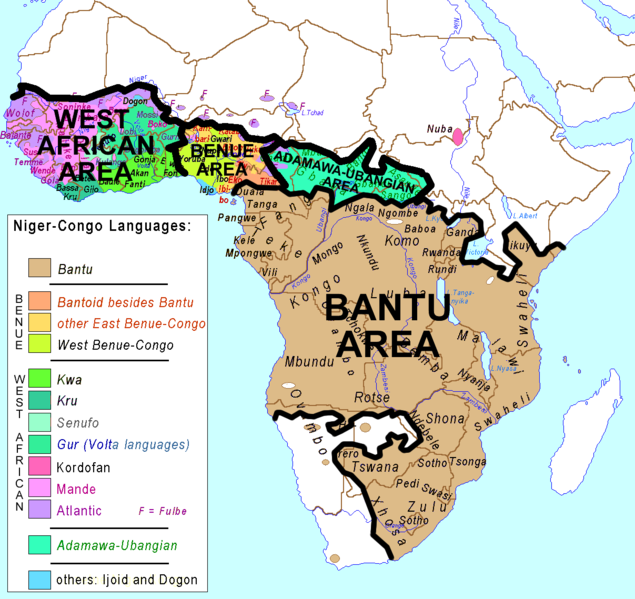 |
|
|
|
Post by zarahan on Mar 27, 2014 11:37:04 GMT -5
COPIED HERE: TRUTHTEACHER SAID: Oookaay. Not sure what the Sphinx has to do with the population of West Africa. If I wasn't mistaking you tried to insinuate through the fact that the oldest pottery (which was Nilotic) is found in Mali (West Africa) And what evidence do you have that the people living there 11,400 yrs ago were Nilotics? How can you determin ethnic groups from pottery that ancient? Was there anything in the video that said they were Nilotic?that it's the oldest form of innovation in Africa Pottery. I was talking about pottery. However, the crafting of pottery was a technological advancement that wasn't seen anywhere else in Africa at that time. Not only is this the oldest pottery in Africa, but it's among some of the oldest examples of pottery in the world.and that the Nile Valley civilization is the result of that innovation. I said no such thing. I gave that as evidence to prove West Africa was inhabited at a very early time. If the pottery is 11,400yrs old, we have to infere that people had been living there for a much longer time before they developed the technology of pottery. This means the region has been inhabited for a very long time. Further investigation needs to be done to see how wide spread and how old this culture is.I provided the facts pointing to the true age of the Sphinx in ancient Egypt to dispel that implication, as it proves that a highly advanced civilization with sophisticated culture created by the Anu (our ancestors) had thrived on the Nile Valley for over 10,000 years. We will have to agree to disagree on the age of the Sphinx as there has been no conclusive evidence yet. If it is water erosionit could have been due to flooding from the river. The course of the river use to come very close to the plataue, so its possible that it either was periodically innundated or, that the water table in that area is very high and it's soaking up ground water. I've touched it several times. It's limestone, but not a very good quality, it's very soft. The temple beside it on the other hand is made out of a very hard stone. So until conclusive evidence is presented I'll stick to what I know so far. I don't doubt it could be older, thousands of years older though, I doubt it personally. But as always, I remain open to receive any changes.
In any case, the age of the Shinx is irrelivant. My point is not that the West African culture contributed to Egypt, but that the area was inhabited. What ethnic group they may or may not have belonged to is irrelivant. The relivant point is there were humans there and if we study more, we are sure to find evidence that would make the current Bantu migration theory obsolete, or at least shine more light on the peopling of the continent.On the flip side I've seen quite a bit of evidence that suggest that the innovators of pyramid building were in fact those earlier Nilotic Saharans. I say this because of the earliest pyramids being found in Niger and Mali (unsure of this date however): Mali (date unknown by me) Zinger, Niger (found like 3 years ago) Zinger, Niger (found like 3 years ago)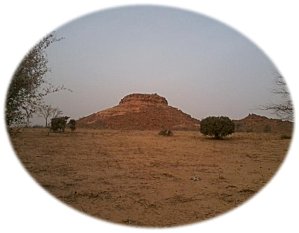 Article Article (of course only African outlets and a few blogs even report this recent findings). Anansi already spoke to this, but I will say that the sources are not credible. If you are making an academic argument, you don't use blogs as a source. Anyone can say anything on a blog. As far as African sources Sheikh Anta Diop was an African source and he rocked everybodies world at the time. He didn't do it with hear say evidence, or comlaining about western science. He used the scholarship and science of the day, linguistics, anthropology, etc to prove his points. He showed similarities in artifacts and cultural practices to prove his point. He was so well prepaired that UNESCO had to accept that a lot of what he said was true. This is why UNESCO came out with General History of Africa 2. You keep saying "West Africa" and attaching no context to whatever it is that you are trying to prove. You said that Mali was West Africa not the Sahara, implying that West Africa and the Sahara desert are mutually exclusive categories.... 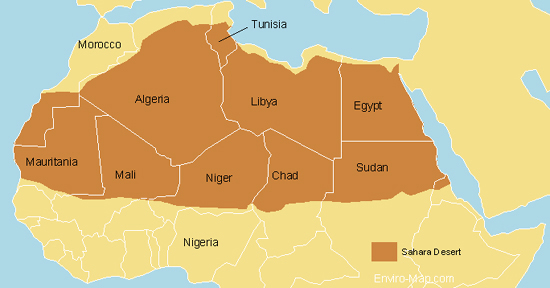 ...^^ You therefore make no sense.
The problem here that you keep reading ideas into my statements that were never intended nor implied. The Sahara is a region that spans from West Africa to East Africa. Yes, a great deal of Mali is in the Sahara and Sahel region. It's also a West African nation. So Mali is West African, Saharan and Sahelian, therefore, I make perfect sense. Yes "West Africa" and I several times I've specified specifically "tropical" Africa (referring to the fertile areas of West Africa where most of us are today). Do you remember what I said about those isolated settlements in this region? I ask because you sure didn't respond to that explanation ( here), but you keep trying to come with these silly responses like this stuff hasn't been explained to you already. 
My point is very clear. I see that West Africa, the region on the western portion of the continent which includedthe tropical, and arid zones were populated from a very early age. Therefore, I do not accept the notion that the region was empty untill it was settled by Egyptian immigrants. I dug out one of my old books General History of Africa 1 Methodology and African Prehistory, (1989). According to the chapter on West African prehistory the early stone age ended 50,000 years bc. The earliest artifacts being found in Senegal, Guinea, Muritania and Ghana.
The Middle Stone Age spans35,000 to 15, 000yrs before christ. Artifacts being found in Ghana, Nigeria, Ghana, Ivory Coast. My point here is that the archeological evidence available at the printing of this book showed very old human habitation in that part of Africa. They had been there way before the formation of any of the cultures in Nubia or Egypt. Therefore, the population of this area cannot be explained in simple terms of an Egyptian migration. |
|
|
|
Post by zarahan on Mar 27, 2014 11:38:10 GMT -5
COPIED HERE:
--------------------
ANANSI SAID:
The iron age may have started way earlier in central/west Africa then we previously thought it may very well be an independent invention
but the issue of Iron smelting in the region is complex If for example advanced uses of Iron came to the Nile Valley through the middle men of the Assyrians,remember the Kushite/Kemites forces lost mainly because their bronze weapons shattered against Assyrian Iron,it was only then after that crushing defeat did they truly developed a viable Iron age technology which could then be dispersed throughout Africa,however there seemed to be a glich as "some" those Africans south and to the west had an iron age industry a good 1500yrs before either Kemet or Kush, how ever the lost wax process of the Nok may well be defused technology.
al~Takruri
|
|
|
|
Post by zarahan on Mar 27, 2014 11:38:50 GMT -5
COPIED HERE: ASANTE SAID: ------------------------------- And what evidence do you have that the people living there 11,400 yrs ago were Nilotics? Well for one your date of 11,400 for the first pottery is unfounded. The oldest pottery found was in Mali and is estimated to be around 9,400 years ago. Now what migration occurred in the ancient Sahara around this time? Map of the earliest pottery (note Mali)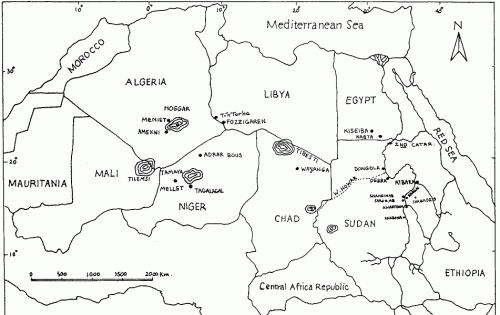  link linkThat's the evidence that the earliest pottery makers were in fact the result of this Nilotic expansion INTO the ancient Sahara during the 10th millennium B.C. lol No it isn't. It's an idea that you just don't want to accept so you are obfuscating everything (examples of your silliness are pointed out throughout this thread). You see at this point in the discussion it's clear that your hissy fit counter "arguments" (if you want to call it a argument) aren't leading to anything coherent. All you and some other people are trying do is " win a debate" not have an " intelligent discussion". In intelligent discussion you at least try to address every major relevant point that a person makes in a response. You on the other hand cut every major explanation for this out of your responses to me. That tells me and everyone watching that you are just trying to win a debate...so it all boils down to "Ego" with you and some people. If you're wrong you're wrong. You only make yourself look stupid ( killing your credibility as a serious thinker) when you keep going with the debunked arguments and irrelevant side talk (advice). |
|
|
|
Post by zarahan on Mar 27, 2014 11:40:39 GMT -5
COPIED HERE- ZARAHAN SAID:
Original homeland of the Bantu up to 1500 A.D.
So far three different sources have validated that every native Egyptian pharaoh (9 so far) has been characterized by M2 lineages, hence why everytime the closest world matches for DNAtribes are Southern Africa, The Great Lakes (heavily Nilotic influenced), and of course West Africa (not the Horn nor the Sahel). Thanks to "off brand" (non Western) researchers we now (at least to me) have quite a stock pile of irrefutable cultural and linguistic parallels which can ONLY be explained through this explanation of these Africans having migrating from ancient Egypt (as they say that they did).
So then you are no longer saying the Bantu migrations are related to Taharqas return to the Sudan? I just want to make sure of Taharqa and the Bantu link here. I have no problem with Bantu DNA linking with Egyptian DNA at various levels- as we can see via Haplogroup E lineages. But you say directly above that it all narrows down to Africans MIGRATING FROM ANCIENT EGYPT. That is the point of contention. Clarify here: What groups are you claiming migrated out when from Egypt? What time frames?
1) Pre dynastic?
2) Early Dynastic?
3) Middle Dynas?
4) Hyksos era?
5) Tarhaqua's return to Sudan?
6) Final end of dynsties
This is where I seek clarification. If you are saying there was ancient Niger-Congo or Nilo-Saharan or Afro-Asiatic movement West I have no problem with that per se. It's these migrations FROM Egypt as you say above, that I am trying to pin down. Of the 6 time periods above- WHO was migrating out from Egypt, and where did they go? We are in agreement with certain points, but this migration out is unclear.
But notice that they are in the Sahara region of "West Africa" not the lush tropical regions of West Africa that we dominate today. These people were likely those who went on to form the later ancient Ghana empire (Mali/Burkina-Fasco).
Fair enough.
re you just skipping past everything that I say about the northward expansion of the "Negroid" Pleistocene Nubians INTO Egypt from Sudan and points further? Did you read anything that I said about the Nilotes in the ancient Sahara and that I suspect that they are the innovators of pyramid building that later appeared on the Nile Valley?
These were never at issue.
you would know that the southern Egyptian population immediately went into Kush (Nubia) following Taharqa. An exodus from Kush (NOT Egypt) is want brought us into our current locations as reads in the captions of those two black in white maps that I provided. Another fact to note is that iron smelting was s major thing that they did in Kush. The likely event that triggered our migration from Kush into our contemporary locations was the move of the Capitol city from Napata further south into Meroe around 591. The first signs of the Nok civilization in Nigeria sprang up around 500 B.C. Now we have a major change that occurs in Nubia (Kush) and ironically in this same century time frame a civilization springs up in Nigeria. This civilization that suddenly springs up in Nigeria also has the new technical innovation of that seen in Kush which is iron smelting, coincidence (doubt it)?
OK but now you have shifted from your original premise of MIGRATIONS FROM EGYPT,
that laid the basis for Nok etc etc.. OK, so you are now saying that migrations from Nubia
created the advanced cultures of West Africa (Mali, Ghana- lets say,) and one key proof of
that is seen in the movement of Meriotic iron-working technology that shows up further West? I have no problem with this scenario per se, just looking at the chain of evidence and logic.
Alright- how would the move of the capital south trigger than migration into West Africa? Seems to me too pat a reason. Can you bolster this angle with additional evidence? Can you pull into some info from a few books on West African history for example to help build your chain? For example in some books I see claims that certain types of sickle cell patterns suggest movement from the East (dont know how true- Google Mande and sickle cell), or that speak of the influence of the Mande speakers in the Empire of Mali.
In reality the Kintampo site was a break off of the Mande people (one of our groups) who had previously created the the oldest civilization in "West Africa" (Dhar Tichit/Mauritania):
OK but you have shifted from first suggesting West Africa was virtually uninhabited prior to 2000BC, which is what also caused Truthseeker to question the scenario. Do you have more to bolster the notion of the Mande creating the oldest civilization at Dhar Tichit? Why the Mande speakers and not someone else?
Your revised scenario has some merit but needs bolstering. Can you pull in language evidence to support your proposed chain of movement? Mande root words suggesting expansion south and west to Mali for example? Pottery styles indicating movement or trade with Saharan sources, and so on?
What about radiation out from Tichit?? Were there other centers of diffusion?
Keep on accruing new data and sharing it as you build your theory.
|
|
|
|
Post by zarahan on Mar 27, 2014 11:41:45 GMT -5
|
|
|
|
Post by zarahan on Mar 27, 2014 11:42:55 GMT -5
COPIED HERE: tRUTHTREACHER SAID: ------------------------ And what evidence do you have that the people living there 11,400 yrs ago were Nilotics? Well for one your date of 11,400 for the first pottery is unfounded. The oldest pottery found was in Mali and is estimated to be around 9,400 years ago. Now what migration occurred in the ancient Sahara around this time? No, my dates aren't wrong. Again, look at the video. This is what they say. The carbon dating gave it an age of 11,400yrs old. How old is that map you're looking at?Map of the earliest pottery (note Mali)  link linkThat's the evidence that the earliest pottery makers were in fact the result of this Nilotic expansion INTO the ancient Sahara during the 10th millennium B.C. That isn't any type of evidence for a Nilotic expansion. The quote says nothing about any migration, only that the region is home to one of the oldest examples of the technology. That's an example of you reading your own interpritation into the situation. If there were people in that part of Africa in the Early stone age at least 50,000yrs ago, you don't need any later migrations to explain the advent of pottery technology. It could mean that those Stone Age people living there eventually developed the technology themselves.lol No it isn't. It's an idea that you just don't want to accept so you are obfuscating everything (examples of your silliness are pointed out throughout this thread). You see at this point in the discussion it's clear that your hissy fit counter "arguments" (if you want to call it a argument) aren't leading to anything coherent. All you and some other people are trying do is " win a debate" not have an " intelligent discussion". In intelligent discussion you at least try to address every major relevant point that a person makes in a response. You on the other hand cut every major explanation for this out of your responses to me. That tells me and everyone watching that you are just trying to win a debate...so it all boils down to "Ego" with you and some people. If you're wrong you're wrong. You only make yourself look stupid ( killing your credibility as a serious thinker) when you keep going with the debunked arguments and irrelevant side talk (advice). Can't you ever answer a direct question? The only thing silly here is the way you avoid answering direct questions by accusing people of having some sort of agenda. You've debunked nothing. So if you don't mind, can you just answer the question with an explanation that doesn't involve a whole lot of rambling and photo spam? Once again, I'm specifically addressing your statement that West Africa was unihabited until Egyptian migration. I provided detailed evidence the region was inhabited long before that period. You countered by saying that you explained it to me. The link you provided is the page when you were talking about your theory of the age of the Sphinx, which had nothing to do with nothing. So, again, can you explain the fact that West Africa from Ghana to Mauritania was inhabited tens of thousands of years before you said it was? This is a very simple question. If you have an answer could you please give it, because whatever you think you explained to me..... I didn't see. Can you restate it with out directing me to a page about nothing relavant? Just give me a direct answer in your own words in one or 2 or as many paragraphs as you need. Easy and reasonable request. Thanking you in advance and eagerly looking forward to your reply. TT |
|
|
|
Post by zarahan on Mar 27, 2014 11:43:57 GMT -5
COPIED HERE: ASANTE SAID: ----------------------------- If there were people in that part of Africa in the Early stone age at least 50,000yrs ago, you don't need any later migrations to explain the advent of pottery technology. lol Man you sound just like the headlines of one of those Egyptsearch information graphics right here (no offense). Your "counter-argument" is in no way coherent as it does not contain any original thought from you nor does it lead to any type of narrative of events (just broad baseless assumptions). Do you know that the oldest skull found outside of Africa is 1.8 million years old? linkSo according to your silly logic the fact that human remains were found in Georgia (Europe) 1.8 million years ago means that " you don't need any later migrations to explain" (like the generally accepted Out of Africa migration around a mere 70k years ago) how the people in the region today got there. Clearly this finding represents an individual or culture that DIED OUT, which means that there was no continuation of that particular legacy. This means that later events that happened in that area in such vast a time period are not (or don't have to be) related (now possibly inspired by) to those much earlier events. Can you provide evidence of the continuation of this culture in the region from that 50,000 year time period? So the correspondence of dating shown on both maps which puts Nilotic Nilo-Saharan speakers in the ancient Sahara during the 10 millenium B.C. and the oldest pottery in the Sahara (Mali) also during the 10 millenium B.C. is not evidence that Nilotic Africans are the innovators of pottery? Once again from one of the sources regarding the time line of events.: linkNow the date and details that YOU have confused revolve around: link"Ceramics" does not equate to pottery. Ceramic is a more general term and practice which in this case only refers to human or animal sculptures (cultural) being sculpted out of the heated clay. Pottery on the other hand refers to making a ceramic functional, and by that I mean the ceramic process switches from being for strictly cultural expressions to making use of the clay in the form of bowls, cups, vases ect. Do you understand? Now what migration placed distinct groups of Africans in that region before that 10 millenium period which would explain how ceramics where there for a millennium prior?  The proper context of this migration has been explained already. That big orange area just south of Northwest Africa in the same region of the Sahara (Mali/West Africa) where these ancient ceramics were found pretty much explains itself does it not? The advancement from ceramics to pottery coincide with the introduction of Nilotic Africans in the 10 century B.C. which is also when the first pottery in Africa was found in that same area of the Sahara. Do you still need help? |
|
|
|
Post by truthteacher2007 on Mar 27, 2014 19:52:43 GMT -5
COPIED HERE: ASANTE SAID: ----------------------------- linkNow the date and details that YOU have confused revolve around: link"Ceramics" does not equate to pottery. Ceramic is a more general term and practice which in this case only refers to human or animal sculptures (cultural) being sculpted out of the heated clay. Pottery on the other hand refers to making a ceramic functional, and by that I mean the ceramic process switches from being for strictly cultural expressions to making use of the clay in the form of bowls, cups, vases ect. Do you understand?
In English, ceramics does refer to pottery. I invite you to read this pasage from the source you yourself linked to:[b]
"But the unearthing of the ancient fragments of burnt clay is one of the most significant to date. Huysecom is convinced that pottery was invented in West Africa to enable man to adapt to climate change.
"Apart from finding the oldest ceramic in Africa, the interesting thing is that it gives us information about when and under what circumstances man can invent new things, such as pottery," he explained.
"And the invention of ceramic is linked to specific environmental conditions – the transformation of the region from desert into grassland."[/b][/font] Once again, here's the video for anyone who wants to see it. Skip ahead to 44:22. Don't forget to read the subtitles.With regards to later migrations into the area, I'd be willing to say there were several. There is no evidence that the inhabitants who were there 50,000yrs died out as is the obvious case in Europe since modern humand didn't arrive in Europe until about 40, or so thousand yrs ago. Therefore, it's not out of the realm of possability to assume that these people later developed pottery techhnology. However, if we don't do more study of the region, we will never know for sure. That's why I keep saying we need to pay more attention to these areas and not make the ssumption that there's nothing there to find. Furthermore, even though the region was inhabited doesn't mean that others couldn't migrate in at later periods and settle areas not settled, or merge with the people already there, or both. Once again, this is why we need to do more archeological investigations in the various areas of Africa.
Lastly, with regards to the Afro Asiatic map..... Yeah, there's no dates on that thing and the other map shows a date of 9,400yrs bce, which matches the dates given in the video, 9,400yrs before Christ + 2,000 yrs since Christ till now = 11,400 yrs old. |
|
















